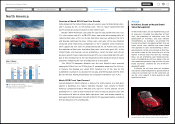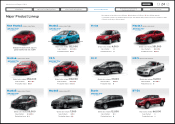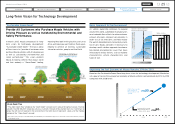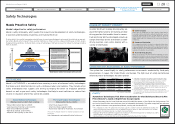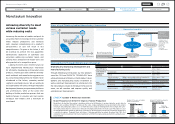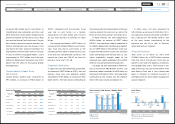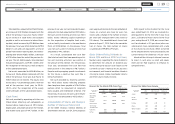Mazda 2014 Annual Report Download - page 31
Download and view the complete annual report
Please find page 31 of the 2014 Mazda annual report below. You can navigate through the pages in the report by either clicking on the pages listed below, or by using the keyword search tool below to find specific information within the annual report.
Performance Improve Cost / Efficiency
R&D Efficiency 30% or more
Investment in
Production
Facilities
SKYACTIV-G/D 70% or more
Vehicle 20% or more
Cost
Improvement
Vehicle (excluding
additional equipment)
100kg or more weight reduction (equivalent to
5% fuel economy improvement)
20% or more ¬ 30%
(target)
SKYACTIV-D 20% better fuel economy, Euro6 compliance Better than current engine
SKYACTIV-G 15% better fuel economy and torque, possible to
comply with Euro6
Better than current
direct-injection engine
SKYACTIV-DRIVE 4–7% better fuel economy, direct feeling
improvement
Same as current
transmission
Monotsukuri Innovation
Dramatically improving development and
manufacturing costs
Through Monotsukuri Innovation, our new products
since the CX-5 and SKYACTIV TECHNOLOGY have
achieved improved efficiency in both product devel-
opment and manufacturing facility investment as
well as significant improvements in vehicle costs. For
the new products we plan to introduce in the years to
come, we will maintain and improve quality and
accelerate cost improvements.
Increasing the number of models and parts to
accurately meet increasingly diverse customer
needs reduces productivity and increases
costs. However, compromising on a product’s
attractiveness or cost will result in lost
competitiveness. To grow in the future, it will
be essential to achieve the two apparently
contradictory objectives of optimally and
accurately addressing customer needs, and
utilizing mass production to reduce costs and
offer products at a competitive price.
Looking five to 10 years into the future, we
have implemented Monotsukuri Innovation
for efficiently developing and manufacturing
products, making possible common develop-
ment methods and manufacturing processes
by using integrated planning for models to be
introduced in the future, spanning market
segments and model classes. We are aiming to
raise operational efficiency through integrated
development planning using common platforms
and architectures, while at the same time
building a flexible production process that can
handle changes in volumes and can quickly
introduce new models with a minimum of
investment.
Achieving diversity to meet
various customer needs
while reducing costs
CHECK Example of Monotsukuri Innovation
Mixed Production of SKYACTIV Engines (Flexible Production)
Regardless of whether the engine is gasoline or diesel, or differences in engine capacity, we are able to
process and assemble SKYACTIV engines on the same single production line by considering the engine
structure and production process as a set from the early stages of development. For example, the cylin-
der block processing line used to be a dedicated multiple production line made up of 45 processes, but
we amalgamated the number of processes into four by utilizing generic machinery capable of processing
a variety of engines. Through these initiatives, it became possible to reduce by more than 70% the
amount of facility investment for the installation of a SKYACTIV engine compared with the amount previ-
ously needed.
Aims of and Thinking behind Monotsukuri Innovation
Improvements through Monotsukuri Innovation
Monotsukuri Innovation
Common
Architecture
Concept
Integrated Planning
Flexible Production
Concept
Production Development
Support joint
production
methods that
create economies
of scale
• Common use of
platforms, parts,
and systems with
integrated
planning
• Design that
considers
production lines
• More-efficient production of
various competitive models
Performance
target
Cost target
Improve
performance
Cost
improvement
45 processes
Down by
more than 70%
Previously:
Dedicated
multiple line
SKYACTIV engines:
Utilizing
generic machinery
Previously:
Dedicated
multiple line
SKYACTIV engines:
Utilizing
generic machinery
4
processes
Number of Processes on Cylinder
Block Processing Line
Amount of Facility Investment in
Engine Production Line
Balance conflicting cost improvement
with improved performance through
Monotsukuri Innovation
Target
Previous
Position
Support production of many
competitive products
29
Mazda Annual Report 2014
CONTENTS
Review of Operations
Foundations Underpinning
Sustainable Growth
Message from Management
Introduction
Brand Value Management
Financial Section


